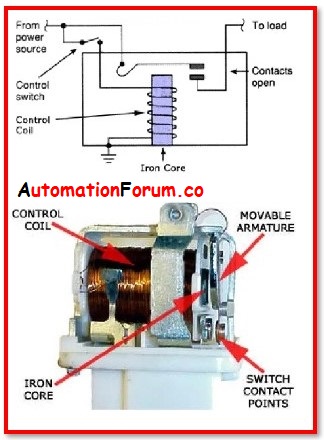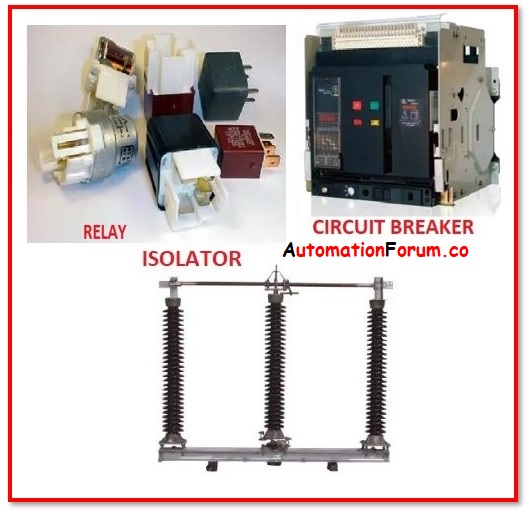What is a Relay?
Relays are switching devices that are used to control the flow of electricity, and by extension, the circuit to which it is directed. By managing the current flow through an electromechanical assembly or a solid state circuit, a relay can be used to switch a circuit and activate/deactivate among several connected to it instead of manually turning it on or off. The relay ensures complete electrical isolation between the regulated and control circuits and is operated by a low power signal.

Properties of a Relay:
- The relay is a manually operated device that opens and closes connections to control the operation of other electric circuit-connected devices.
- The relay is utilised in circuits with a maximum 20A ampere capacity.
- Their size is smaller.
- At least two NO/NC connections are present.
- They are included into switching, automation, control, and protection circuits.
What is a Circuit Breaker?
An automatic switch known as a circuit breaker is an on-load device created utilising electromechanical techniques to guard against short circuits or damage from power overloads. A solenoid is located inside a circuit breaker and is maintained at a specific voltage level to maintain the balance of the triggering mechanism. The switch is activated and the current flow is stopped when a fault in the circuit, such as an overload or short circuit, is detected. The circuit breaker can be turned back on once the relevant electrical issue has been resolved.

Properties of a Circuit Breaker:
- Circuit Breaker is used to safeguard electrical circuits from harm brought on by overcurrent from short circuits.
- When a fault is found, it effectively interrupts the flow of current. Following the handling or repair of the defect, it can be reset to operate normally. Therefore, unlike fuses, which can only be used once, a circuit breaker can be used several times.
- It is a device that, under normal circumstances, can be operated manually or remotely to make or break the circuit.
- Its ability to automatically break the circuit under malfunctioning circumstances is the primary factor in its appeal.
- Examples include the vacuum, SF6, and air blast circuit breakers etc.
What is an Isolator?
An electrical circuit is isolated from current passing through it using a mechanical switch called an isolator. When necessary for operation, fault discovery, or maintenance operations, isolators are utilised to locally power on and power off machinery. Isolators are employed when there is no load on, not when a machine or system is operating and current is flowing through components.

Properties of an Isolator:
- The Isolator or Isolating Switch is the tool used to isolate a system component for upkeep and repairs.
- Only when there is no load can it open the circuit.
- Due to the aforementioned characteristic, a circuit breaker must be opened before opening isolators when two isolators are linked on either side of it.
- Isolators must be closed first, followed by the circuit breaker, in order to bring the system online after the repair work on the circuit breaker is finished.
Difference between Relay, Circuit Breaker, and Isolator:
| SPECIFICATION | RELAY | CIRCUIT BREAKER | ISOLATOR |
|---|---|---|---|
| Functions | Relays function with low power input voltage. | Circuit breakers are ON Load device. | Isolators are OFF Load device. |
| Where is used? | Relays are typically used in control panels, manufacturing automation, and building automation to switch smaller current levels in control circuits and control power. | It can be found in residences as well as electricity generation and distribution facilities. | Electrical distribution facilities and power plants both have isolators. |
| Method of Arc Quenching | Provided | Provided | Not provided |
| Location | Various devices contain relays that are concealed. | It is circuit-connected. | It connects to a region on both sides. |
| Automatic/ Manual | It can be controlled automatically. | It is an automated system. | It can be controlled manually or automatically. |
| Necessity for maintenance | Every 2 years, it must essential for maintenance. | Every 2 years, it must essential for maintenance. | Every 3 to 5 years, it must undergo maintenance. |
| When they are connected to the same circuit, the order of use | It should operate before the circuit breaker and the isolator. | It should operate before the isolator. | It should operate after the circuit breaker. |
| Withstand Capability | They have the high withstand capability. | They have a strong withstand capability at on load operation. | Compared to Circuit Breakers, they have a lower withstand capability. |






